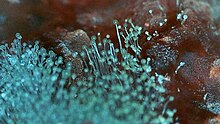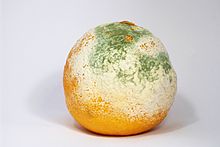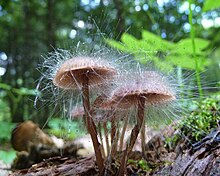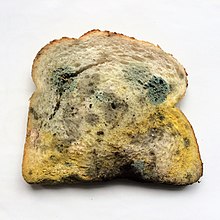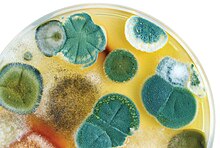Amold(US,PH) ormould(UK,CW) is one of the structures that certainfungican form. The dust-like, colored appearance of molds is due to the formation ofsporescontainingfungal secondary metabolites.The spores are the dispersal units of the fungi.[1][2]Not all fungi form molds. Some fungi formmushrooms;others grow assingle cellsand are calledmicrofungi(for exampleyeasts).
A large andtaxonomicallydiverse number of fungal species form molds. The growth ofhyphaeresults in discoloration and a fuzzy appearance, especially on food.[3]The network of these tubular branching hyphae, called amycelium,is considered a singleorganism.The hyphae are generally transparent, so the mycelium appears like very fine, fluffy white threads over the surface. Cross-walls (septa) may delimit connected compartments along the hyphae, each containing one or multiple, genetically identicalnuclei.The dusty texture of many molds is caused by profuse production of asexual spores (conidia) formed by differentiation at the ends of hyphae. The mode of formation and shape of these spores is traditionally used to classify molds.[4]Many of these spores are colored, making the fungus much more obvious to the human eye at this stage in its life-cycle.
Molds are considered to bemicrobesand do not form a specifictaxonomicorphylogeneticgrouping, but can be found in the divisionsZygomycotaandAscomycota.In the past, most molds were classified within theDeuteromycota.[5]Mold had been used as a common name for now non-fungal groups such aswater moldsorslime moldsthat were once considered fungi.[6][7][8]
Molds causebiodegradationof natural materials, which can be unwanted when it becomesfood spoilageor damage to property. They also play important roles in biotechnology and food science in the production of various pigments, foods, beverages,antibiotics,pharmaceuticals andenzymes.[9]Some diseases of animals and humans can be caused by certain molds: disease may result from allergic sensitivity to mold spores, from growth ofpathogenicmolds within the body, or from the effects of ingested or inhaled toxic compounds (mycotoxins) produced by molds.[1]
Biology
editThere are thousands of known species of mold fungi with diverse life-styles includingsaprotrophs,mesophiles,psychrophilesandthermophiles,and a very fewopportunistic pathogensof humans.[10]They all require moisture for growth and some live in aquatic environments. Like all fungi, molds derive energy not throughphotosynthesisbut from theorganicmatter on which they live, utilizingheterotrophy.Typically, molds secrete hydrolyticenzymes,mainly from the hyphal tips. These enzymes degrade complexbiopolymerssuch asstarch,celluloseandlignininto simpler substances which can be absorbed by the hyphae. In this way, molds play a major role in causingdecompositionof organic material, enabling the recycling of nutrients throughoutecosystems.Many molds also synthesizemycotoxinsandsiderophoreswhich, together withlyticenzymes, inhibit the growth of competingmicroorganisms.Molds can also grow on stored food for animals and humans, making the food unpalatable or toxic and are thus a major source of food losses and illness.[11]Many strategies forfood preservation(salting, pickling, jams, bottling, freezing, drying) are to prevent or slow mold growth as well as the growth of other microbes.
Molds reproduce by producing large numbers of smallspores,[10]which may contain a singlenucleusor bemultinucleate.Mold spores can be asexual (the products ofmitosis) or sexual (the products ofmeiosis); many species can produce both types. Some molds produce small,hydrophobicspores that are adapted for wind dispersal and may remain airborne for long periods; in some the cell walls are darkly pigmented, providing resistance to damage byultraviolet radiation.Other mold spores have slimy sheaths and are more suited to water dispersal. Mold spores are often spherical or ovoid single cells, but can be multicellular and variously shaped. Spores may cling to clothing or fur; some are able to survive extremes of temperature and pressure.
Although molds can grow on dead organic matter everywhere in nature, their presence is visible to the unaided eye only when they form largecolonies.A mold colony does not consist of discrete organisms but is an interconnected network of hyphae called amycelium.All growth occurs at hyphal tips, withcytoplasmand organelles flowing forwards as the hyphae advance over or through new food sources. Nutrients are absorbed at the hyphal tip. In artificial environments such as buildings, humidity and temperature are often stable enough to foster the growth of mold colonies, commonly seen as a downy or furry coating growing on food or other surfaces.
Few molds can begin growing at temperatures of 4 °C (39 °F) or below, so food is typicallyrefrigeratedat this temperature. When conditions do not enable growth to take place, molds may remain alive in a dormant state depending on the species, within a large range of temperatures. The many different mold species vary enormously in their tolerance to temperature and humidity extremes. Certain molds can survive harsh conditions such as the snow-covered soils of Antarctica, refrigeration, highly acidic solvents, anti-bacterial soap and even petroleum products such as jet fuel.[12]: 22
Xerophilicmolds are able to grow in relatively dry, salty, or sugary environments, wherewater activity(aw) is less than 0.85; other molds need more moisture.[13]
Common molds
editCommongeneraof molds include:
Food production
editTheKōji moldsare a group ofAspergillusspecies, notablyAspergillus oryzae,and secondarilyA. sojae,that have been cultured in eastern Asia for many centuries. They are used to ferment a soybean and wheat mixture to makesoybean pasteandsoy sauce.Kojimolds break down thestarchin rice, barley, sweet potatoes, etc., a process calledsaccharification,in the production ofsake,shōchūand other distilled spirits.Kojimolds are also used in the preparation ofKatsuobushi.
Red rice yeastis a product of the moldMonascus purpureusgrown on rice, and is common in Asian diets. The yeast contains several compounds collectively known asmonacolins,which are known to inhibit cholesterol synthesis.[14]A study has shown that red rice yeast used as a dietary supplement, combined with fish oil and healthy lifestyle changes, may help reduce "bad"cholesterolas effectively as certain commercialstatindrugs.[15]Nonetheless, other work has shown it may not be reliable (perhaps due to non-standardization) and even toxic to liver and kidneys.[16]
Somesausages,such assalami,incorporate starter cultures of molds[17]to improve flavor and reduce bacterial spoilage during curing.Penicillium nalgiovense,for example, may appear as a powdery white coating on some varieties of dry-cured sausage.
Other molds that have been used in food production include:
- Fusarium venenatum–quorn
- Geotrichum candidum–cheese
- Neurospora sitophila–oncom
- Penicilliumspp. – various cheeses includingBrieandBlue cheese
- Rhizomucor miehei– microbialrennetfor making vegetarian and other cheeses
- Rhizopus oligosporus–tempeh
- Rhizopus oryzae– tempeh,jiuquforjiuniangor precursor for makingChinese rice wine
Pharmaceuticals from molds
editAlexander Fleming's accidental discovery of the antibioticpenicillininvolved aPenicilliummold calledPenicillium rubrum(although the species was later established to bePenicillium rubens).[18][19][20]Fleming continued to investigate penicillin, showing that it could inhibit various types of bacteria found in infections and other ailments, but he was unable to produce the compound in large enough amounts necessary for production of a medicine.[21]His work was expanded by a team at Oxford University; Clutterbuck, Lovell, and Raistrick, who began to work on the problem in 1931. This team was also unable to produce the pure compound in any large amount, and found that the purification process diminished its effectiveness and negated the anti-bacterial properties it had.[21]
Howard Florey,Ernst Chain,Norman Heatley,Edward Abraham,also all at Oxford, continued the work.[21]They enhanced and developed the concentration technique by using organic solutions rather than water, and created the "Oxford Unit" to measure penicillin concentration within a solution. They managed to purify the solution, increasing its concentration by 45–50 times, but found that a higher concentration was possible. Experiments were conducted and the results published in 1941, though the quantities of penicillin produced were not always high enough for the treatments required.[21]As this was during the Second World War, Florey sought US government involvement. With research teams in the UK and some in the US, industrial-scale production of crystallized penicillin was developed during 1941–1944 by theUSDAand by Pfizer.[18][22]
Severalstatincholesterol-lowering drugs (such aslovastatin,fromAspergillus terreus) are derived from molds.[23]
The immunosuppressant drugcyclosporine,used to suppress the rejection of transplanted organs, is derived from the moldTolypocladium inflatum.
Health effects
editMolds areubiquitous,and mold spores are a common component of household and workplace dust; however, when mold spores are present in large quantities, they can present a health hazard to humans, potentially causing allergic reactions and respiratory problems.[24]
Some molds also produce mycotoxins that can pose serious health risks to humans and animals. Some studies claim that exposure to high levels of mycotoxins can lead to neurological problems and, in some cases, death.[25]Prolonged exposure, e.g. daily home exposure, may be particularly harmful. Research on the health impacts of mold has not been conclusive.[26]The term "toxic mold" refers to molds that produce mycotoxins, such asStachybotrys chartarum,and not to all molds in general.[27]
Mold in the home can usually be found in damp, dark or steamy areas, e.g. bathrooms, kitchens, cluttered storage areas, recently flooded areas, basement areas, plumbing spaces, areas with poor ventilation and outdoors in humid environments. Symptoms caused by mold allergy are: watery, itchy eyes; a chronic cough; headaches or migraines; difficulty breathing; rashes; tiredness; sinus problems; nasal blockage and frequent sneezing.
Molds can also pose a hazard to human and animal health when they are consumed following the growth of certain mold species in stored food. Some species produce toxic secondary metabolites, collectively termedmycotoxins,includingaflatoxins,ochratoxins,fumonisins,trichothecenes,citrinin,andpatulin.These toxic properties may be used for the benefit of humans when the toxicity is directed against other organisms; for example,penicillinadversely affects the growth of Gram-positive bacteria (e.g.Clostridiumspecies), certainspirochetesand certainfungi.[28]
Growth in buildings and homes
editMold growth in buildings generally occurs as fungi colonize porous building materials, such as wood.[29]Many building products commonly incorporate paper, wood products, or solid wood members, such as paper-covered drywall, wood cabinets, and insulation. Interior mold colonization can lead to a variety of health problems as microscopic airborne reproductive spores, analogous to tree pollen, are inhaled by building occupants. High quantities of indoor airborne spores as compared to exterior conditions are strongly suggestive of indoor mold growth.[30]Determination of airborne spore counts is accomplished by way of an air sample, in which a specialized pump with a known flow rate is operated for a known period of time. To account for background levels, air samples should be drawn from the affected area, a control area, and the exterior.
The air sampler pump draws in air and deposits microscopic airborne particles on a culture medium. The medium is cultured in a laboratory and the fungal genus and species are determined by visual microscopic observation. Laboratory results also quantify fungal growth by way of a spore count for comparison among samples. The pump operation time is recorded and when multiplied by pump flow rate results in a specific volume of air obtained. Although a small volume of air is actually analyzed, common laboratory reports extrapolate the spore count data to estimate spores that would be present in a cubic meter of air.[31]
Mold spores are drawn to specific environments, making it easier for them to grow. These spores will usually only turn into a full-blown outbreak if certain conditions are met.[32]Various practices can be followed to mitigate mold issues in buildings, the most important of which is to reduce moisture levels that can facilitate mold growth.[27]Air filtration reduces the number of spores available for germination, especially when a High Efficiency Particulate Air (HEPA) filter is used. A properly functioning AC unit also reduces the relative humidity in rooms.[33]The United States Environmental Protection Agency (EPA) currently recommends that relative humidity be maintained below 60%, ideally between 30% and 50%, to inhibit mold growth.[34]
Eliminating the moisture source is the first step at fungal remediation. Removal of affected materials may also be necessary for remediation, if materials are easily replaceable and not part of the load-bearing structure. Professional drying of concealed wall cavities and enclosed spaces such as cabinet toekick spaces may be required. Post-remediation verification of moisture content and fungal growth is required for successful remediation. Many contractors perform post-remediation verification themselves, but property owners may benefit from independent verification. Left untreated, mold can potentially cause serious cosmetic and structural damage to a property.[35]
-
Moldy housecorner from outside and inside
-
Mold stains on agift cardwith package which was stored unintentionally for six months in an open compartment in a motorcycle
Use in art
editVarious artists have used mold in various artistic fashions. Daniele Del Nero, for example, constructs scale models of houses and office buildings and then induces mold to grow on them, giving them an unsettling, reclaimed-by-nature look.[36]Stacy Levysandblasts enlarged images of mold onto glass, then allows mold to grow in the crevasses she has made, creating a macro-micro portrait.[37]Sam Taylor-Johnson,director ofNowhere BoyandFifty Shades of Grey(among others), has made a number of time-lapse films capturing the gradual decay of classically arranged still lifes.[38]
See also
edit- Bioaerosol– Airborne particles containing living organisms
- Decay– Process in which organic substances are broken down into simpler organic matter
- Indoor mold– Fungal growth that develops on wet materials
- Medicinal fungi– Fungi that can be used to develop medications
- Mildew– Form of fungus
- Mold mite– Species of mite
- Mycorrhiza– Fungus-plant symbiotic association
- Oomycete– Fungus-like eukaryotic microorganism
- Slime mold
- Water mold
References
edit- ^abMoore D, Robson GD, Trinci AP, eds. (2011).21st Century Guidebook to Fungi(1st ed.).Cambridge University Press.ISBN978-0521186957.
- ^Madigan M, Martinko J, eds. (2005).Brock Biology of Microorganisms(11th ed.).Prentice Hall.ISBN978-0-13-144329-7.OCLC57001814.
- ^Morgan, Mike."Moulds".Microscopy UK.Archivedfrom the original on 28 March 2019.Retrieved26 June2012.
- ^Chiba University, Japan."Fungus and Actinomycetes Gallery".Chiba University Medical Mycology Research Center.Archivedfrom the original on 19 July 2012.Retrieved26 June2012.
- ^Hibbett DS, Binder M, Bischoff JF, Blackwell M, Cannon PF, Eriksson OE, et al. (2007)."A higher level phylogenetic classification of theFungi"(PDF).Mycological Research.111(5): 509–547.CiteSeerX10.1.1.626.9582.doi:10.1016/j.mycres.2007.03.004.PMID17572334.S2CID4686378.Archived fromthe original(PDF)on 2009-03-26.
- ^"Slime Molds".herbarium.usu.edu.Utah State University.Archivedfrom the original on 20 February 2020.Retrieved21 April2020.
- ^"Slime Molds: Myxomycetes"(PDF).Cornell University.Retrieved21 April2020.
- ^"Introduction to the Oomycota".ucmp.berkeley.edu.UC Berkeley.Archivedfrom the original on 6 May 2020.Retrieved21 April2020.
- ^Toma, Maria Afroz; Nazir, K. H. M. Nazmul Hussain; Mahmud, Md Muket; Mishra, Pravin; Ali, Md Kowser; Kabir, Ajran; Shahid, Md Ahosanul Haque; Siddique, Mahbubul Pratik; Alim, Md Abdul (2021)."Isolation and Identification of Natural Colorant Producing Soil-Borne Aspergillus niger from Bangladesh and Extraction of the Pigment".Foods.10(6): 1280.doi:10.3390/foods10061280.PMC8227025.PMID34205202.
- ^abRyan KJ, Ray CG, eds. (2004).Sherris Medical Microbiology(4th ed.). McGraw Hill. pp.633–8.ISBN978-0-8385-8529-0.
- ^Wareing, Peter."The Fungal Infection of Agricultural Produce and the Production of Mycotoxins".European Mycotoxins Awareness Network.Archived fromthe originalon 19 October 2013.Retrieved3 August2013.
- ^Malloch, D. (1981).Moulds: their isolation, cultivation and identification.Toronto Canada: Univ. of Toronto Press.ISBN978-0-8020-2418-3.
- ^Pitt JI, Hocking AD (2009). "Xerophiles".Fungi and Food Spoilage.London: Springer. pp.339–355.doi:10.1007/978-0-387-92207-2_9.ISBN978-0-387-92206-5.
- ^"Red yeast rice (Monascus purpureus)".Mayo Clinic.2009-09-01.Archivedfrom the original on 2010-02-06.Retrieved2010-02-01.
- ^"Study: Red Rice Yeast Helps Cut Bad Cholesterol".National Public Radio.2008-07-01.Archivedfrom the original on 2010-02-12.Retrieved2010-02-01.
- ^Red Yeast Rice Preparations: Are They Suitable Substitutions for Statins?, Dujovne, CA, Am J Med. 2017 Oct;130(10):1148-1150. doi: 10.1016/j.amjmed.2017.05.013. Epub 2017 Jun 7.
- ^Sunesen LO, Stahnke LH (November 2003). "Mould starter cultures for dry sausages—selection, application and effects".Meat Science.65(3): 935–948.doi:10.1016/S0309-1740(02)00281-4.PMID22063673.
- ^ab"The Nobel Prize website".Archivedfrom the original on 19 May 2012.Retrieved27 June2012.
- ^Houbraken, Jos; Frisvad, Jens C.; Samson, Robert A. (2011)."Fleming's penicillin producing strain is not Penicillium chrysogenum but P. rubens".IMA Fungus.2(1): 87–95.doi:10.5598/imafungus.2011.02.01.12.PMC3317369.PMID22679592.
- ^Houbraken, J.; Frisvad, J.C.; Seifert, K.A.; Overy, D.P.; Tuthill, D.M.; Valdez, J.G.; Samson, R.A. (2012-12-31)."New penicillin-producing Penicillium species and an overview of section Chrysogena".Persoonia - Molecular Phylogeny and Evolution of Fungi.29(1): 78–100.doi:10.3767/003158512X660571.PMC3589797.PMID23606767.
- ^abcd"Award Ceremony Speech".Nobel Prizes and Laureates.Nobel Media.Archivedfrom the original on 27 May 2014.Retrieved26 May2014.
- ^"Pfizer's work on penicillin for World War II becomes a National Historic Chemical Landmark".American Chemical Society.June 12, 2008.Archivedfrom the original on August 8, 2016.RetrievedJune 14,2016.
- ^Cox, Russell J.; Simpson, Thomas J. (2010). "Fungal Type I Polyketides".Comprehensive Natural Products II.p. 355.doi:10.1016/B978-008045382-8.00017-4.ISBN9780080453828.
Lovastatin (also known as mevinolin) is produced by Aspergillus terreus
- ^Gent, Janneane F; Ren, Ping; Belanger, Kathleen; Triche, Elizabeth; Bracken, Michael B; Holford, Theodore R; Leaderer, Brian P (December 2002)."Levels of household mold associated with respiratory symptoms in the first year of life in a cohort at risk for asthma".Environmental Health Perspectives.110(12): A781–6.doi:10.1289/ehp.021100781.ISSN0091-6765.PMC1241132.PMID12460818.
- ^Empting, L. D. (2009). "Neurologic and neuropsychiatric syndrome features of mold and mycotoxin exposure".Toxicology and Industrial Health.25(9–10): 577–81.Bibcode:2009ToxIH..25..577E.doi:10.1177/0748233709348393.PMID19854819.S2CID27769836.
- ^Money, Nicholas (2004).Carpet Monsters and Killer Spores: A Natural History of Toxic Mold.Oxford, UK: Oxford University Press. pp.178.ISBN978-0-19-517227-0.
- ^abIndoor Environmental Quality: Dampness and Mold in BuildingsArchived2020-05-07 at theWayback Machine.National Institute for Occupational Safety and Health. August 1, 2008.
- ^Saunders Comprehensive Veterinary Dictionary, Blood and Studdert, 1999
- ^Fairey, Philip; Chandra, Subrato; Moyer, Neil."Mold Growth".Florida Solar Energy Center.University of Central Florida.Archivedfrom the original on 27 August 2019.Retrieved19 August2019.
- ^IICRC S500 Standard and Reference Guide for Professional Water Damage Restoration
- ^"Prestige EnviroMicrobiology, Inc".prestige-em.Archivedfrom the original on 2017-03-01.Retrieved2018-03-26.
- ^"A Brief Guide to Mold, Moisture and Your Home".EPA.13 August 2014.
- ^"Facts About Mold".aiha.org.Retrieved2018-03-26.
- ^"A Brief Guide to Mold, Moisture and Your Home".US EPA.13 August 2014. Archived fromthe originalon January 6, 2020.Click on "Moisture and Mold Prevention and Control Tips".
- ^"What is Mold?".gtamoldremoval.14 September 2024.
- ^Solon, Olivia (30 November 2010)."Artist uses mould to create decayed architectural models".Wired UK.Archivedfrom the original on 19 August 2019.Retrieved19 August2019.
- ^"The Art of Mould".Discard Studies.2 January 2012.RetrievedMay 11,2015.
- ^"Still Life, 2001".Sam Taylor-Johnson.Archived fromthe originalon 2017-03-24.Retrieved2017-03-23.
